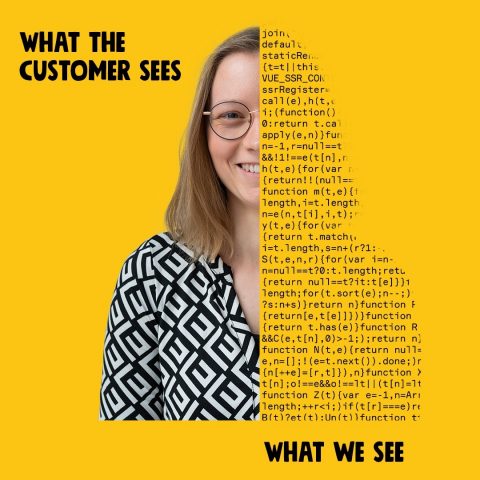In 2022 we decided it was time to upgrade to a new search engine called Bloomreach. One of the specialists involved was Rowena Belt, Tester and – since a few weeks – Scrum Master at our Jumbo Tech Campus. She talks us through her experiences and the process of switching search engines. Spoiler alert: ‘switching’ sounds a lot simpler than it was in this case.
Bloomreach
Let’s start with the new search engine: Bloomreach. It holds many interesting features and a lot of potential for the future. It handles language much like we humans would do. For example, Bloomreach understands synonyms, so when you search for ‘bread’, it will also return ‘rolls’, ‘sandwiches’ or ‘croissants’ when those results are relevant. Perfect for a language like Dutch, that has quite a few different words for anything made of dough.
Back to reading the manual
The benefits of switching, for our customers and our business, were clear from the start, but you just don’t swap an engine out that easily. Rowena explains: “The transition had a profound effect on many elements of our front-end, backend and even our business. Before Christmas of 2022, it had to be up and running.”
Jumbo does not take any chances with their IT infrastructure during the busiest time of the year. And 9 months to complete a project may sound like plenty of time, but we knew very little about Bloomreach, so everybody literally had to start from square one: reading the documentation.
The handover
The implementation was a two-part and two-team effort. The first team implemented the basic functionalities. The core of the engine, so to speak. The second team joined the first. Again, the lack of knowledge about the new engine caused a slight delay. Rowena: “Getting the new team members up to speed took some time. We documented everything we did, introduced the new team to Bloomreach and showed them what we had done. Next, we had to ensure we were on the same page for the next phases of the transition. I stayed with the project, so I got to work with the second team as well.
So much for routine
For Rowena, this process also meant she would have to adjust her way of working. “When I test familiar software, I know where to look and what to look for. I can automate part of the testing process, like I did with the regression tests for my team. But this was something completely new. I had to find my way and get to know the software, paying attention to every detail. It was challenging, but also very rewarding.”
During the implementation and testing phases, the team members had to work fast and closely together. Rowena: “The developers were dependent on us testers and the other way around. It felt like real teamwork, and it was. In the end we pulled it off. The main part of the implementation was done, and some extra features are still being added now.”
If you look hard enough…
The dynamics within this project differed strongly from the standard project. Rowena: “If there’s even such a thing as a standard project in an organization as complex as Jumbo. In this transition, so many parties were involved. We worked with front- and backend developers, app developers and people from the business. We had a lot of input, and we did a lot of testing.”
However, there’s a limit to how long and how much you can test. In Rowena’s words: “If you look hard enough, you will always find something. The trick is to test and improve the code enough to ensure our customers can use the functionalities without encountering major errors. And that’s what we managed to do. When we moved everything to the live environment, there were no error messages, no bugs, no weird looking pages. Nothing but a good looking, working search system.”
Behind the scenes
Jumbo’s client probably won’t notice the changes right away, but over time they will notice their search results becoming more relevant and even more spot on. That may sound like the teams worked hard for nothing, but that’s not how Rowena sees it: “To me, it’s a compliment. It means the transition was successful.” From now on, Rowena’s work will become a little easier. A dashboard now shows her how data was entered and/or what has changed, so looking for errors while testing will take less time and effort. Plus: she can now test more independently from the development team, although some tasks will always require cooperation. She could even do it from home, for example. Rowena: “Which is nice, but I really enjoy being around my team members, so I join them as often as I can.”
Scrum Master
So far, we only addressed the testing part of Rowena’s job. But recently she took on an extra responsibility. She became a scrum master. Rowena: “I’m still discovering that role. It’s much more about managing processes and enabling teams to do their best work. The management part is new for me. But I’m eager to learn and I get a lot of support from the people around me. So, I’m sure it will work out.”
Does this mean Rowena is done testing? Her answer to that question is a clear ‘No’. Rowena: “It’s far too much fun to do. I really enjoy helping developers iron out the rough spots. So, for the foreseeable future, you will still find me chasing bugs and other ‘unintended features”
Interested in a job at Jumbo Tech Campus? Let’s make IT amazing! Become part of the back bone of Jumbo.

